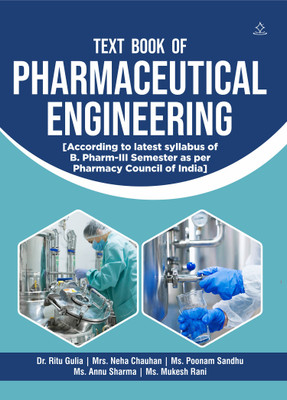TEXT BOOK OF PHARMACEUTICAL ENGINEERING - According to latest syllabus of B. Pharm-III semester as per Pharmacy Council of India(Paperback, Dr Ritu Gulia, Mrs. Neha Chauhan, Ms. Poonam Sandhu, Ms. Annu Sharma, Ms. Mukesh Rani)
Quick Overview
Product Price Comparison
The Textbook of Pharmaceutical Engineering is a comprehensive guide that covers essential engineering principles and unit operations relevant to the pharmaceutical industry. Designed to meet the academic requirements of pharmacy students, it integrates both theoretical concepts and practical applications. The book begins with the study of Flow of Fluids, explaining Reynolds number, BernoulliŌĆÖs theorem, and the use of devices like manometers and venturimeters. Size Reduction explores mechanisms, factors, and equipment such as hammer mills and ball mills. Size Separation details the classification of powders, official standards, and separation equipment including sieve shakers and cyclone separators. In Heat Transfer, the book covers conduction, convection, and radiation, along with heat exchangers. The Evaporation chapter describes multiple types of evaporators and factors influencing the process. Distillation includes simple, fractional, and vacuum techniques used for purifying liquids. The Drying section highlights mechanisms, drying curves, and equipment like tray dryers and freeze dryers. Mixing is explored through solid and liquid mixing, with detailed descriptions of ribbon blenders, sigma mixers, and emulsifiers. The Filtration chapter addresses filter aids, media, and devices such as plate-and-frame filters and rotary drum filters. Centrifugation explains principles and machines used for solid-liquid separation. A unique aspect of the book is its focus on Materials of Plant Construction, discussing corrosion types, their prevention, and suitable construction materials. Each chapter includes principles, construction, working, uses, advantages, and limitations of pharmaceutical equipment. The content is well-illustrated and clearly structured for ease of understanding. Case studies and examples link theory to real-world pharmaceutical processes. The book also emphasizes energy efficiency, safety, and compliance with regulatory norms. It encourages problem-solving through exercises and conceptual clarity. Students benefit from concise explanations paired with detailed diagrams. The integration of mechanical engineering with pharmaceutical needs makes it a vital learning tool. It prepares readers for roles in manufacturing, formulation, and quality control. Updated information ensures relevance to modern industrial practices. The book balances academic rigor with practical relevance. It promotes sustainable and efficient process design. Its logical flow helps in gradual learning.

